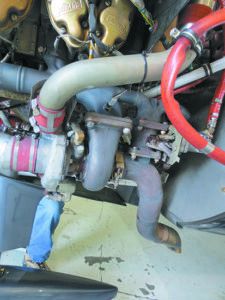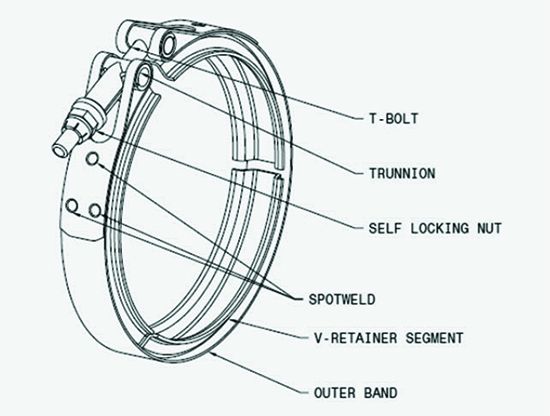V-band couplings—or more simply, the clamps used to secure the engine’s tailpipe to the exhaust housing—are a well-known maintenance concern on turbocharged engines. Like the FAA and NTSB, mechanics have seen plenty of clamp failures over the years, so it’s no surprise that the FAA has adopted AD 2023-09-09, a means to keep a focused eye on potential pipe clamp failures on a variety of turbocharged airplanes and helicopters.
There’s nothing extraordinarily complicated here. The bands are secured with a t-bolt and trunnion mechanism that is either riveted or spot-welded in place, and over time, the spot-weld can generate cracks leading to the failure of the clamp. The clamp can fail prematurely if someone overtorqued the t-bolt. Put it in the category of maintenance-induced failures we consistently read about in wreck reports.

Regardless, the FAA started talking about the issue last year in a proposed AD (which goes into effect on July 17, 2023) that would require repetitive inspections of turbocharged engines that had spot-welded, multi-segment v-band couplings at the tailpipe where it mounts to the turbocharger housing flange. As proposed, the action is annual inspection (regardless of the time the clamp was in service), and a component life limited by shotgunning the clamp every 500 hours.
To give you an idea of how this kind of rulemaking generally works, there were various tech recommendations from a working group (manufacturers, type/owner groups and the FAA) tasked with examining turbocharger-to-tailpipe designs and failures of the v-band couplers. It isn’t a one design fits all, so logically the group recommended mandatory corrective actions tailored to each specific coupling type (spot-welded, riveted or single piece), in hopes of minimizing effort and costs. In addition to life-limit replacement (and annual inspection), the group also recommended non-mandatory guidance to help educate mechanics what to look for while inspecting the parts, plus suggestions for a new design.
Ultimately, the group found mostly fatigue failures from stress-corroded spot-welds in multi-segment couplings. While some clamps are backstopped with safety wire, that won’t do much good with transverse band cracking and total failure of the spot-weld. In January 2018, the group published the report “Exhaust System Turbocharger to Tailpipe V-band Coupling/Clamp Working Group Final Report” and in it, Appendix B covers best practices. This docket number FAA-2022-0891 (at www.regulation.gov) is worth a read.
The AD says clamp replacement (31,248 are in service on single-engine aircraft and 9810 on twins) should take roughly 2.0 hours of shop time, plus $400 in parts, per engine.


